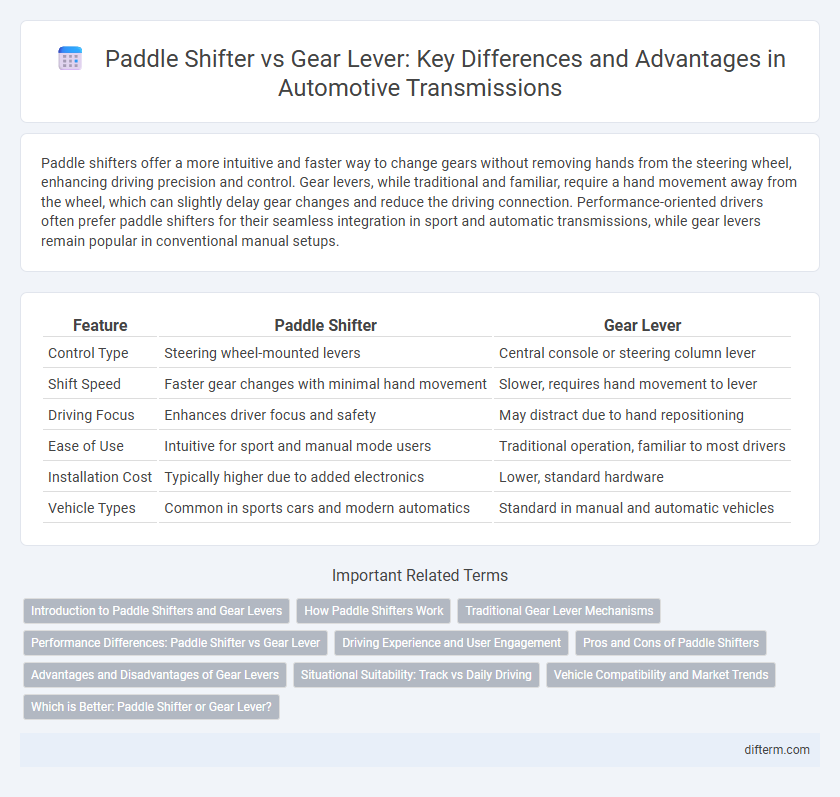Paddle shifters offer a more intuitive and faster way to change gears without removing hands from the steering wheel, enhancing driving precision and control. Gear levers, while traditional and familiar, require a hand movement away from the wheel, which can slightly delay gear changes and reduce the driving connection. Performance-oriented drivers often prefer paddle shifters for their seamless integration in sport and automatic transmissions, while gear levers remain popular in conventional manual setups.
Table of Comparison
| Feature | Paddle Shifter | Gear Lever |
|---|---|---|
| Control Type | Steering wheel-mounted levers | Central console or steering column lever |
| Shift Speed | Faster gear changes with minimal hand movement | Slower, requires hand movement to lever |
| Driving Focus | Enhances driver focus and safety | May distract due to hand repositioning |
| Ease of Use | Intuitive for sport and manual mode users | Traditional operation, familiar to most drivers |
| Installation Cost | Typically higher due to added electronics | Lower, standard hardware |
| Vehicle Types | Common in sports cars and modern automatics | Standard in manual and automatic vehicles |
Introduction to Paddle Shifters and Gear Levers
Paddle shifters provide drivers with quick and precise gear changes by allowing manual control without removing hands from the steering wheel, enhancing both convenience and driving performance. Gear levers, traditional manual transmission controls, require more deliberate hand movement and offer a tactile, mechanical connection to the vehicle's transmission system. Understanding the differences in ergonomics and responsiveness between paddle shifters and gear levers is crucial for optimizing driving experience in modern automotive design.
How Paddle Shifters Work
Paddle shifters enable drivers to manually change gears by using small levers located behind the steering wheel, allowing for quick and precise gear shifts without taking hands off the wheel. These electronically or hydraulically controlled paddles send signals to the transmission system to upshift or downshift, enhancing driving performance and control. Modern paddle shifters integrate seamlessly with automatic and dual-clutch transmissions to provide a sporty, manual-like driving experience.
Traditional Gear Lever Mechanisms
Traditional gear lever mechanisms in automotive transmission systems offer tactile feedback and intuitive control, enhancing driver engagement and precision. Unlike paddle shifters, gear levers provide a physical connection to the gearbox, supporting manual gear changes in both automatic and manual transmissions. This mechanical setup is favored in performance vehicles for its reliability, direct feel, and the ability to manage complex gear patterns efficiently.
Performance Differences: Paddle Shifter vs Gear Lever
Paddle shifters enable faster gear changes by allowing drivers to shift without removing their hands from the steering wheel, improving response times and maintaining vehicle control. In contrast, traditional gear levers require manual hand movement, which can slow down shift times and reduce precision during high-performance driving. Performance-oriented vehicles often favor paddle shifters for their ability to deliver quicker, smoother gear transitions, enhancing overall driving dynamics.
Driving Experience and User Engagement
Paddle shifters offer a more dynamic driving experience by allowing drivers to change gears quickly without taking their hands off the steering wheel, enhancing control and responsiveness. Gear levers provide a traditional tactile feel, appealing to drivers who prefer physical interaction and more deliberate gear changes. The choice between paddle shifters and gear levers significantly impacts user engagement, with paddle shifters rewarding skillful driving and gear levers fostering a classic connection to the vehicle.
Pros and Cons of Paddle Shifters
Paddle shifters offer rapid and precise gear changes without removing hands from the steering wheel, enhancing driving control and safety in performance vehicles. They provide a sporty and engaging driving experience, but may be less intuitive for drivers unfamiliar with manual gear selection and can increase complexity in routine city driving. Compared to traditional gear levers, paddle shifters reduce physical effort and shifting time, yet lack tactile feedback that some drivers prefer for manual control.
Advantages and Disadvantages of Gear Levers
Gear levers offer precise manual control over gear selection, enabling smoother acceleration and enhanced driving performance, especially in performance vehicles. However, they require greater driver skill and attention, increasing the likelihood of gear mis-shifts compared to paddle shifters. Gear levers also occupy more cabin space and can be less ergonomic, potentially affecting driver comfort during extended use.
Situational Suitability: Track vs Daily Driving
Paddle shifters excel in track environments by enabling rapid gear changes without removing hands from the steering wheel, enhancing control and response during high-speed maneuvers. Gear levers offer intuitive operation and precise gear selection, making them well-suited for daily driving scenarios where comfort and familiarity take precedence. Selecting between paddle shifters and gear levers depends on whether the priority is performance-oriented shifting or ergonomic ease in everyday traffic.
Vehicle Compatibility and Market Trends
Paddle shifters are increasingly compatible with modern automatic and dual-clutch transmission vehicles, particularly in sports and luxury car segments, enhancing driver control without removing hands from the steering wheel. Traditional gear levers remain prevalent in entry-level and budget vehicles due to lower production costs and simpler mechanical integration. Market trends indicate a growing preference for paddle shifters in performance-oriented models, driven by consumer demand for seamless shifting and advanced vehicle technology.
Which is Better: Paddle Shifter or Gear Lever?
Paddle shifters offer quicker gear changes and enhanced control by allowing drivers to keep both hands on the steering wheel, improving safety and performance in sporty driving conditions. Gear levers provide a more traditional and tactile driving experience, favoring drivers who prioritize precise manual input and tactile feedback. For high-performance vehicles, paddle shifters are often better suited, while gear levers appeal to enthusiasts seeking a more engaging, hands-on transmission control.
paddle shifter vs gear lever Infographic

 difterm.com
difterm.com